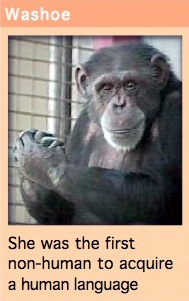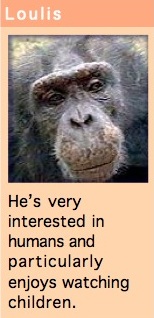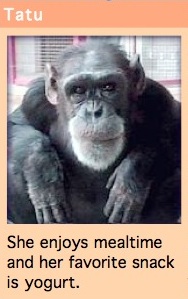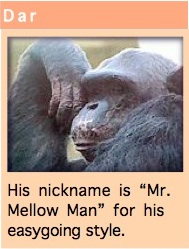“Darwin argued that we resemble our ape kin not only anatomically but mentally as well. We do.” — Roger Fouts, Chimpanzee & Human Communication Institute
“That chimps can communicate is disturbing for some people.” — Asif Agha, professor at UCLA
 |
At first, Fouts, along with other grad students, taught Washoe by pointing to an object such as an apple, making the sign for it, then positioning her hands into that sign.
But they quickly learned the best way was simply having people sign in her presence. Over time she picked up the words.
The first time they realized this was with the sign for toothbrush. For months, they signed it in front of her, not sure she even noticed. Then one day, she saw a toothbrush sitting on a table and, unprompted, signed toothbrush to herself.
“Language is like a dance,” says Fouts, “you get swept up into it. Washoe acquired words instead of us teaching her.”
Darwin Was Right
 |
“Charles Darwin was right.
“Darwin argued that we resemble our ape kin not only anatomically but mentally as well. We do.”
Chimps are capable of using language and rational thought, Fouts maintains, and the difference between humans and chimps is merely a matter of degree. We share a common past and have simply evolved further along, he argues.
A chimp’s capacity for language is not that different from our own, says Fouts, who has his own scientific institute, the Chimpanzee & Human Communication Institute at Central Washington University in Ellensburg, Wash.
By learning how chimps use language and think, we get a hint of what our own ancestors were like millions of years ago.
Genetically Linked
 |
His favorite fact is that 98.4 percent of DNA in humans and chimps is identical.
Washoe and Fouts are still together. She’s the oldest of five chimps at his facility, which is 120 miles southeast of Seattle. All the chimps including Dar, Moja, Tatu and Loulis were bought from laboratories to spare them from life as lab animals. At one time, Fouts dreamed of returning Washoe to the African jungle, but realized she lacked the skills and social network needed to survive.
One day recently at the institute, Washoe approached the window to check out Fouts and two visiting reporters. Washoe signed to Fouts, asking to see the reporters’ shoes, which were cut off from view. Both reporters lifted their feet up to the window and she carefully studied the footwear before walking away. Like a child, Washoe was simply curious.
That day, the chimps weren’t chatty. Communication depends on their mood, and with a hot, sunny day, the chimps opted for lounging on tires and on the grass. On other days, the chimps can be seen signing frequently to Fouts, his assistants and even to each other.
Soy Sauce = Rice Drink
For instance, caregivers put soy sauce on rice for Dar, a 23-year-old male. One day they forgot, so he signed that he wanted rice drink, combining two words he knew.
Scientists have taught other primates to communicate. In Georgia, Emily Sue Savage-Rumbaugh has taught chimps to use an system of symbols to communicate. They point at colorful icons, each with a meaning, to express thoughts and ideas. Researchers in Woodside, Calif. have taught a gorilla named Koko to use sign language.
The idea that humans share a common history and cognitive ability with chimps doesn't sit well within certain religious circles. There’s no reference in the Bible, Torah or Koran about a chimp ancestor. Creationists believe the guiding hand of a higher power—not evolution—gave man breath. Many scientists, too, are skeptical. Despite the decades of work by Fouts, Savage-Rumbaugh and others, some maintain apes aren't capable of using language, that they're simply mimicking and performing on cue.
Noam Chomsky, professor of linguistics at the Massachusetts Institute of Technology, first advanced the theory in 1969 that only humans can use language.
Only humans have a “language organ” located in the left hemisphere of the brain, says Chomsky. It allows children to pick up the language of their culture unlike any other animal offspring. Though no such “organ” has ever been found, Chomsky and others maintain it exists.
Chomsky says language is a gift unique to humans; it’s impossible for chimps or gorillas to have it.
Uncomfortable Feeling
|
Fouts says scientists today operate from the “arrogance model.” They see chimps as “hairy test tubes,” which justifies their performing cruel and painful experiments in the name of science.
Some people accuse Fouts of being anthropomorphic—giving human qualities to animals. But he counters that most scientists are “mechanomorphic,” a word he made up to describe those who regard chimps as some sort of machine for humans to use.
“Scientists have a lot to learn,” says Fouts. “As living things, we must treat other livings things with compassion.”


